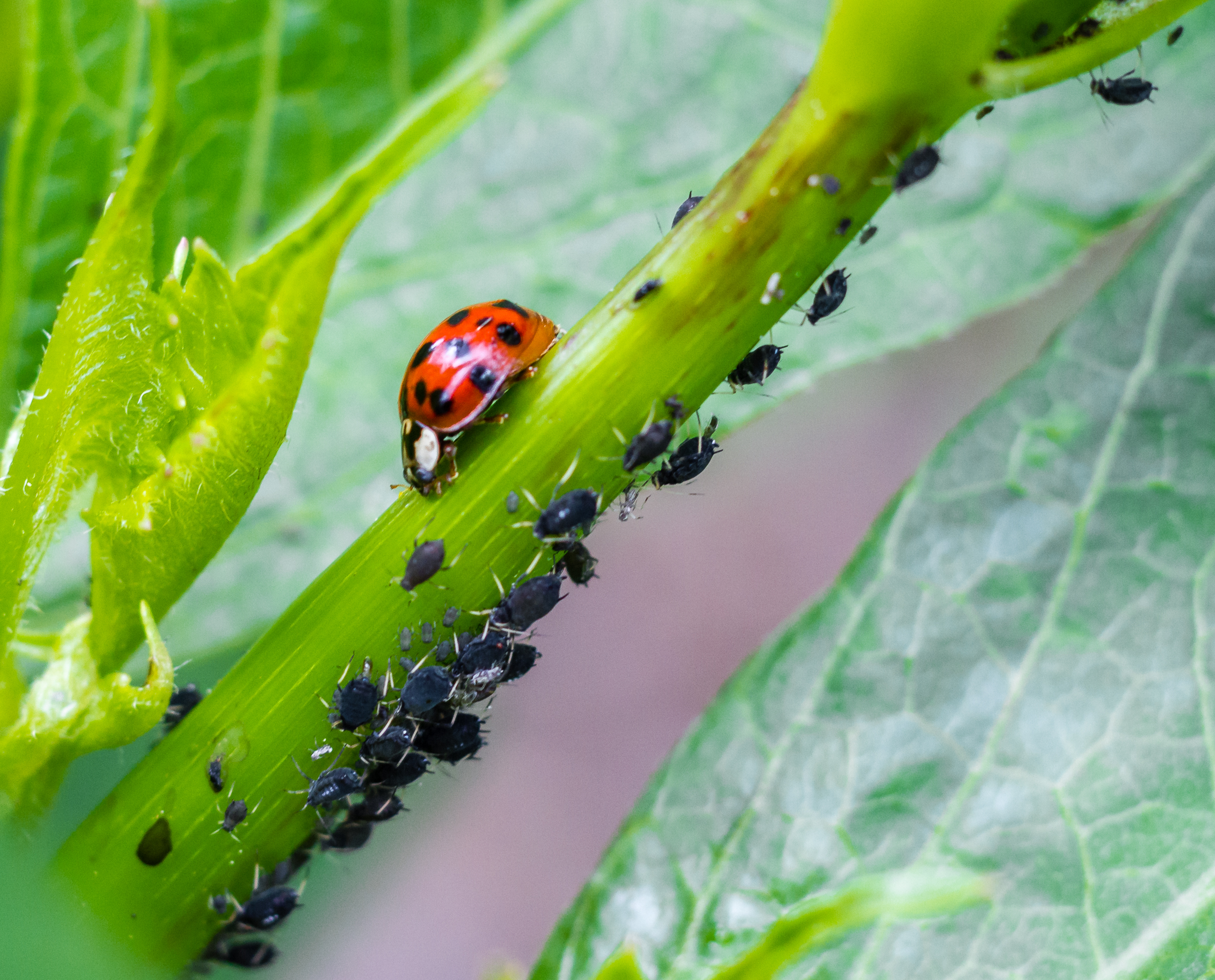Aphids. They’re crawling all over the leaves of my Jerusalem artichokes. They’re tiny, only about a sixteenth to an eighth inch long. They are soft-bodied, and they are shaped rather like a pear. They’re usually green, although specific species may be other colors such as yellow, black or orange.
Aphids have their own family, Aphididae in the scientific classification scheme. Hundreds, perhaps thousands, of species of aphids are found around the world with about a thousand species having been classified. Some species only live on specific plants while others are generalists. All aphids share a few distinctive characteristics. They communicate via chemicals (pheromones) which are emitted via two organs protruding from the back of the abdomen called cornicles. These pheromones control the lifecycle of the individual aphids and the aphid community as a whole. The aphids have long antennae sensitive to this chemical communication. Aphids also release defensive chemicals via their cornicles.
Aphids have specialized mouth parts that they use to pierce plant tissue and suck the sugary juice out of it. The aphid digests the sap, taking the nutrients it needs and disposing of the leftovers in drops of a sticky, sugar-rich liquid called honeydew. The honeydew may attract ants, bees, wasps and flies. It may also attract a black sooty mold. Either way aphids are not welcome in the garden. Sucking the sap out of the leaves, they cause leaves to yellow and die, and if there are enough aphids, they can kill a plant altogether.
Called the mice of the insect world, aphids can reproduce at exponential rates. If one aphid produces eight babies in a day, and those babies mature in a day or so, they will produce 64 babies the next day. Those 64 will mature and produce eight times 64 babies in one day, 512. The next generation will have eight times that or 4096 babies. My math is a little off, but you get the picture. Hopefully there will be plenty of predators to keep the population in check.
Aphids make tasty morsels for a wide variety of insects and spiders including syrphid flies, lacewings and Asian lady beetles. They are slow-moving packets of sugar after all. They are also targets for parasitic wasps who want to lay their eggs inside the aphids.
Aphids have two types of lifecycles. Some species such as rose aphids have evolved to focus on one type of host plant–roses. In this case, an aphid hatches from an egg laid on its preferred host plant. It matures from nymph to adult rapidly and then the adult aphid begins producing live baby aphids at a rate of eight to 12 per day. She can keep this up for up to 30 days before she expires. These aphids spend the summer multiplying at exponential rates through parthenogenesis (asexual reproduction). They remain on the host plant, and when the days are short enough to signal autumn, a generation of the aphids are born able to mate. The females lay their eggs, attaching them by threads or glue to leaves and bark, and the eggs will overwinter and start the cycle again in the spring. Some populations of aphids, such as those tended underground by ant colonies, can continue with uninterrupted parthenogenic reproduction year-round.
Some aphids, like soybean aphids, for instance, require two host plants to complete their life cycle. One host plant (buckthorn in the case of the soybean aphid) serves as the nursery, where the females lay their eggs. The alternate host plant (soybeans for the soybean aphid) serves as the dining room, where aphids eat and eat and eat while also reproducing asexually. These aphids have to get from one plant to the other, so they grow wings and fly there. After gorging on summer crops as wingless forms through as many as 15 generations, a generation once again grows wings and flies back to the first host. The next generation is capable of mating, so they do and start the cycle over again.
Photo from Wikimedia.org by Friedrich Haag Alt text: Life and death and life in the garden. Orange, black-spotted ladybird beetle hunts blue-green aphids on a leaf stem.
